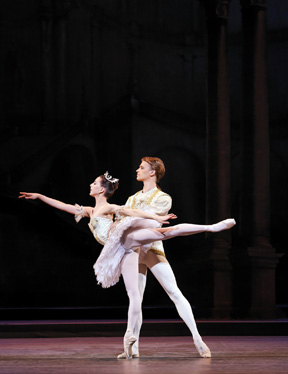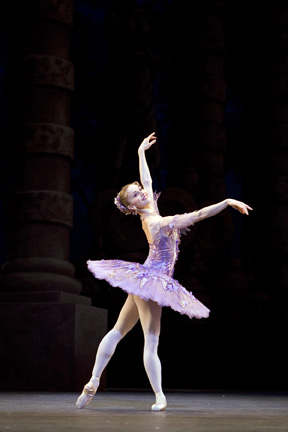Mixed blessings
“The Sleeping Beauty”
The Royal Ballet
Royal Opera House, Covent Garden, London
28 October 28 to 20 December 20, 2006
by John Percival
copyright 2006 by John Percival
 We think of “The Sleeping Beauty” as an old ballet, a relic from the great days of the Imperial Russian theatres. But I am reminded that when I first saw it, February 1946 at Covent Garden, “Beauty” was a few years younger than the present age of several ballets that were made in my time and are still given in versions very like their original: Ashton's “Symphonic Variations” for instance, Balanchine's “Symphony in C”, Robbins's “Fancy Free” or Petit's “Jeune Homme at la Mort”. Yet every company thinks it can change “Beauty” whenever it likes. Why should 19th century ballets have less protection than 20th century works? Just a thought ...
We think of “The Sleeping Beauty” as an old ballet, a relic from the great days of the Imperial Russian theatres. But I am reminded that when I first saw it, February 1946 at Covent Garden, “Beauty” was a few years younger than the present age of several ballets that were made in my time and are still given in versions very like their original: Ashton's “Symphonic Variations” for instance, Balanchine's “Symphony in C”, Robbins's “Fancy Free” or Petit's “Jeune Homme at la Mort”. Yet every company thinks it can change “Beauty” whenever it likes. Why should 19th century ballets have less protection than 20th century works? Just a thought ...
Anyway, I reported in May, when it was first given, on the faults in design, drama and choreography of this new staging of the Royal Ballet's most celebrated classic. It is now back, so soon, for a run of no fewer than 22 showings, and this time I want to concentrate on how they perform it. But first, another point about the first Covent Garden production in the late 1940s was the quality of dancing. Of course the newly transferred and enlarged company was heavily stretched but it had, most of us who saw her would say, the best of all Auroras. Margot Fonteyn had to get used to the big stage and big auditorium, but once this was accomplished she had an unmatched radiance. Don't believe the stories about poor technique, even though she, too modestly, was the first to spread them. Just ask yourself how a ballerina lacking technique could continue successfully until past sixty (that was when she resumed “Spectre de la Rose”!). And incidentally, it was Fonteyn who introduced the long balances into “Beauty”. But what we really loved about her Aurora were its serenity, its musicality — nobody can time that tricky Act 1 solo better than she did — its beauty of line, sheer charm, and, best of all, how she made the meaning and purpose of every dance so clear.
However, it wasn't only Fonteyn who shone way back then. There were other good Auroras, with the Moscow-trained Violetta Prokhorova outstanding among them; there was Beryl Grey as a Lilac Fairy still unbeaten sixty years later; there were interpretations of Carabosse by Robert Helpmann and Frederick Ashton, the like of which would leave present audiences open-mouthed — and Helpmann also gave the Prince more royalty and more romance than you can imagine. Come to that, Leslie Edwards (with Helpmann's encouragement) made even the court chamberlain Cattalabutte a starring role.
 Oh if only we could expect such performances today. Well, there are some merits to report. In May we had seen five Auroras, some of them not so hot. Two more have now been added, making seven casts this time; I got to four of them. And three of those were pretty good. Even the one who disappointed me, first soloist Lauren Cuthbertson in her role debut, danced very proficiently, and some liked her more than I did; it's just that I thought she didn't project much character (in that respect she does better in modern roles). She was handsomely supported by Federico Bonelli as a smoothly appealing Prince Florimund. The other new Aurora — new to us at least — was Alexandra Ansanelli, who danced this season's first performance, a matinee. Of course she had played in New York City Ballet's version before transferring this year to Covent Garden. What a pleasure it was to see not only excellent technique and notably clean, stylish dancing, but a ballerina who truly responds to the music and also makes us aware through both dance and acting what her character feels at each moment. Rupert Pennefather was her Prince; he almost succeeds in making the redundant Hunting Scene solo look acceptable, and elegantly confirms his standing as our best hope for a future danseur noble, although a little too cool right now.
Oh if only we could expect such performances today. Well, there are some merits to report. In May we had seen five Auroras, some of them not so hot. Two more have now been added, making seven casts this time; I got to four of them. And three of those were pretty good. Even the one who disappointed me, first soloist Lauren Cuthbertson in her role debut, danced very proficiently, and some liked her more than I did; it's just that I thought she didn't project much character (in that respect she does better in modern roles). She was handsomely supported by Federico Bonelli as a smoothly appealing Prince Florimund. The other new Aurora — new to us at least — was Alexandra Ansanelli, who danced this season's first performance, a matinee. Of course she had played in New York City Ballet's version before transferring this year to Covent Garden. What a pleasure it was to see not only excellent technique and notably clean, stylish dancing, but a ballerina who truly responds to the music and also makes us aware through both dance and acting what her character feels at each moment. Rupert Pennefather was her Prince; he almost succeeds in making the redundant Hunting Scene solo look acceptable, and elegantly confirms his standing as our best hope for a future danseur noble, although a little too cool right now.
The other major debut was that of Carlos Acosta as Florimund. Everyone thinks of him as a technical virtuoso, and of course he made a fine thing of his solos, but what impressed me most was the noble quality of his bearing and the detail of his acting — not to mention his excellent partnering of Tamara Rojo. I heard complaints that she was too much concerned with brilliant display — amazing balances in the Rose Adagio, and not only triple but even quadruple pirouettes in her Act 1 solo. But she does also give a clear impression of Aurora's growing up. Even more so does Marianella Nunez, my favourite among the present Auroras. She doesn't actually need to smile quite so much as she does, but that only happens because of the joy this young Argentine delight takes in dancing: a potential assoluta if the company learns to make the most of her gifts. Thiago Soares, grand in acting, stylish in dancing, was her gallant partner.
 Soares, incidentally, might also make a stronger Carabosse than this production has yet seen, but the management persists — wrongly, I think — in giving the role to women. Among them, Gillian Revie does give a very sharp-edged account of the wicked fairy, convincing whether she is being baleful or gloating with an evil grin. And it's great news that they have at last found someone who can dance Bluebird — last season's castings all fell short. Andrej Uspenski, born in St Petersburg and trained there, in Dresden and in Berlin, has a fine light jump, brings off the virtuoso steps admirably, and gives the role its distinctive qualities of line and style. I guess he must be about mid-twenties, having danced with the Royal Danish Ballet before moving here. He was also cast in the Florestan pas de trois: not bad but less impressive: inevitably, since the two roles demand such different qualities that nobody in my memory has excelled in both, and I can't see why the management would put the same person in both. Especially since they have now found a very stylish new Florestan in Valeri Hristov, elegant and good-looking. I note that young Steven McRae has also danced Bluebird and I'd expect him to do well, but haven't seen him; others I did see, young Zachary Faruque, Kenta Kura and the more experienced Jose Martin, all showed some good qualities but proved uneven. (How on earth, at the ballet's premiere, did Enrico Cecchetti create these demanding solos for himself when he was already forty — and play Carabosse that same night?)
Soares, incidentally, might also make a stronger Carabosse than this production has yet seen, but the management persists — wrongly, I think — in giving the role to women. Among them, Gillian Revie does give a very sharp-edged account of the wicked fairy, convincing whether she is being baleful or gloating with an evil grin. And it's great news that they have at last found someone who can dance Bluebird — last season's castings all fell short. Andrej Uspenski, born in St Petersburg and trained there, in Dresden and in Berlin, has a fine light jump, brings off the virtuoso steps admirably, and gives the role its distinctive qualities of line and style. I guess he must be about mid-twenties, having danced with the Royal Danish Ballet before moving here. He was also cast in the Florestan pas de trois: not bad but less impressive: inevitably, since the two roles demand such different qualities that nobody in my memory has excelled in both, and I can't see why the management would put the same person in both. Especially since they have now found a very stylish new Florestan in Valeri Hristov, elegant and good-looking. I note that young Steven McRae has also danced Bluebird and I'd expect him to do well, but haven't seen him; others I did see, young Zachary Faruque, Kenta Kura and the more experienced Jose Martin, all showed some good qualities but proved uneven. (How on earth, at the ballet's premiere, did Enrico Cecchetti create these demanding solos for himself when he was already forty — and play Carabosse that same night?)
What we need now is for much more flair, style and enthusiasm to be added to the dull competence shown at present in the ensembles and in many solos, especially the Prologue Fairies and featured roles in Act Three. Even with principal or solo dancers among the casts they don't come off as they should. The programme credits list two producers, a rehearsal director for the staging, a ballet mistress and no fewer than eight principal coaches. What a pity that they don't seem able to get over to the dancers the importance and significance of this ballet, now approaching its 800th performance by the Royal Ballet at Covent Garden plus hundreds more elsewhere.
Photos, all by Johan Persson.
The first two are
of Alexandra Ansanelli and Rupert Pennefather as Princess Aurora and Prince Florimund in the Royal Ballet's production of "The Sleeping Beauty."
Marianella Nunez, here as the Lilac Fairy.
Volume 4, No. 42
November 27, 2006
copyright ©2006 John Percival
www.danceviewtimes.com